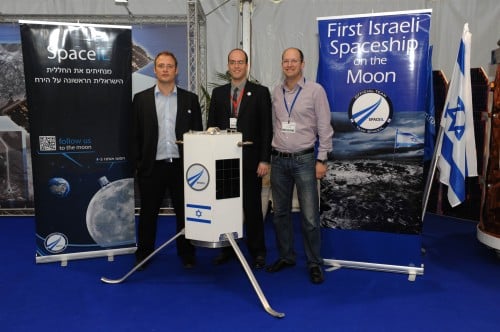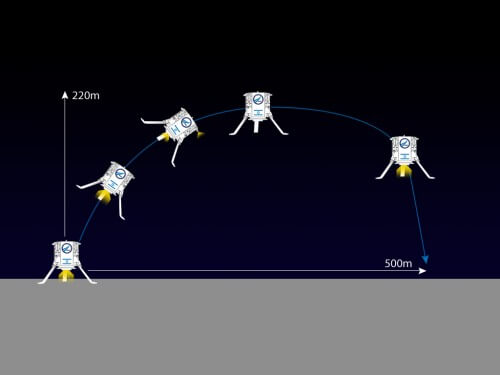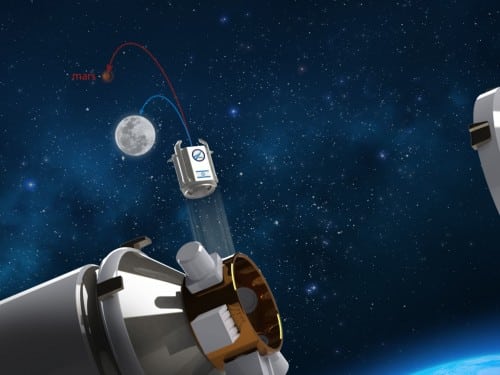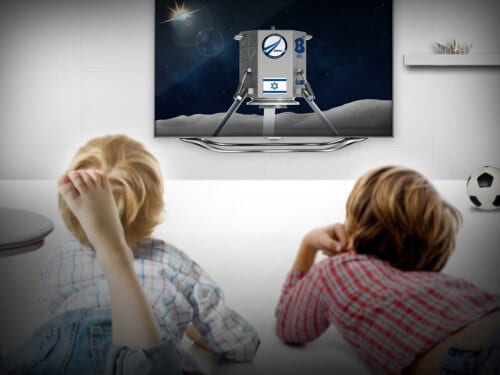SpaceIL has recently successfully completed a Preliminary Design Review conducted with the cooperation of the main parties involved in the design and construction of the spacecraft, mainly the Aerospace Industry


SpaceIL has recently successfully completed a Preliminary Design Review conducted with the cooperation of the main parties involved in the design and construction of the spacecraft and mainly the aerospace industry. The survey is a necessary step in order to move from initial planning to the detailed planning stage, to the hardware and components procurement stage and to the actual construction, which will be carried out physically in the TAA factories.
SpaceIL today reveals the first details regarding the journey to the moon and the unique technologies that will be incorporated into the Israeli spacecraft, which is expected to be the smallest ever launched into space.
How do you take a "ride" into space?
In order to save costs, SpaceIL's spacecraft will join as a "hitchhiker" the satellite of a foreign space company. Unlike a free "ride", the cost of joining such a launch is millions of shekels. The connection to the launcher, which is expected during the year 2015, will be, in fact, the last time that the Israeli engineers will be able to see the Israeli spacecraft with their own eyes. After the connection to the launcher, there will be no communication with the spacecraft for a period of one to two months until all preparations for the launch are completed. The planned target date for launch is 2015.

How long will the journey last for a distance of 384 thousand km?
The orbit - upon exiting the atmosphere, control of the spacecraft will return to Earth and orbit corrections will be made. In this situation, a small mistake is enough and the spacecraft may never reach the moon, or collide with it, God forbid. The orbit is designed so that from a distance of about 400 thousand km (384 thousand on average) from the moon - the spacecraft will be able to be caught in an orbit that is 100 km from the moon (this is similar to trying to thread a needle - from a distance of the fifth floor of a building). The journey is expected to last about a month.
Then, at the appropriate time, they begin a direct flight towards the moon with the aim of being captured by its gravity. From the moment we are captured in lunar orbit, a delay in orbit begins waiting for landing, in a period of up to two weeks, depending on the day of the launch.
What is the weight of the smallest spacecraft in the world and how many fuel tanks does it have?
The weight of the first Israeli spacecraft to the moon is expected to be less than 140 kilos and its size will be approximately 96x72x72 centimeters (at launch). After landing, special springy legs are expected to open in order to stabilize it. The spacecraft is expected to be the smallest ever to land on the moon, and thus the founders of the project and the many partners aim to prove a breakthrough technological ability to build small and smart spacecraft, which cost about a tenth of known spacecraft.
The weight of the spacecraft is mostly due to 4 fuel tanks with a total weight of about 90 kg which should be enough for the huge distance to the moon. SpaceIL engineers are working to reduce the weight of the spacecraft as much as possible, up to a maximum of about 40 kg, which will remain after landing.
How do you navigate in space without GPS?

Unlike the known navigation methods on Earth, there is no GPS in space, so the SpaceIL team had to find and create navigation and course correction solutions specifically, in order to maintain the spaceship's flight path.
Below are a number of original technological developments, as well as means of navigation that will be integrated into the spacecraft:
Earth moon sensor - a unique development of an optical sensor with a camera and image processor, which will take pictures of both the Earth and the Moon so that the spacecraft can position itself in relation to both.
The sensor knows how to identify round objects and distinguish by color whether the photographed object is the Earth or the Moon. The sensor marks the center point of the photographed object and thus helps in positioning the spacecraft.
OpNav - an innovative means of optical navigation: the spacecraft photographs the moon from the position where it is in space and the image is sent from the spacecraft back to the communication station on Earth. At the communication station, the position of the moon compared to the spacecraft is analyzed by comparing the angles of the photos obtained from it to the existing maps.
Another means of navigation that the spacecraft will include is a star tracker, a camera connected to a processor and a memory containing a map of the stars in space. By comparing the image he takes with the map in memory, the tracker can locate the direction of the spacecraft. The combination of these means is intended to provide the best answer to the challenge of space navigation.

So how do you land on the moon?
The landing on the moon will be done gradually, in several stages:
1. Phase A - movement in a circular orbit around the moon, at a distance of 100 km from the surface of the moon.
2. Phase B - descent from a height of 100 km above the surface of the moon, to an altitude of 15 km.
3. Phase C - starting from a height of 15 km above the ground, a no-return order will be given for landing. At this stage the control is critical in light of the fact that the orbit around the moon is particularly challenging and the highest mountain on the moon is 6.5 km above the surface!
How is the spacecraft braked in space and when does it go into free fall?
One of the main challenges during the landing phase is braking the speed of the spacecraft: during the landing phase, the spacecraft can reach a speed of over 7,000 kilometers per hour (2 km per second), which is 8 times faster than the speed of a jet plane. During the entry phase of the spacecraft into orbit around the moon and in order to perform a soft landing and not crash, it will be necessary to stop the spacecraft gradually. A parachute cannot be used on the moon, as there is no air on the moon to fill it and slow the spacecraft down.
Therefore the plan is: use of the rocket engines to lower the speed of the spacecraft to a stop in the air, at a height of only 10 meters from the ground. At this altitude the engines will be turned off and then the spacecraft will begin a vertical free fall with the engines down.
How do you orient yourself during landing and what does it have to do with the sensor on the smartphone?
The most dramatic and critical step in the entire mission is the landing itself. In order to reduce to a minimum the possible problems during the landing, in-depth thinking was done at SpaceIL in order to find solutions to the expected challenges and a number of innovative technological developments were developed.
One of the other original developments is the SLAM (Simultaneous Localization Mapping) - an algorithm for self-positioning during the landing phase. The "Slam" is designed to provide a solution to the main problem, the lack of GPS on the moon and difficulty in the exact location and time of meeting with the ground. The "slam" allows the spacecraft to know where it is in relation to the ground - to prevent a collision with rocks and a crash. This is done by tracking points on the surface, and positioning the spacecraft relative to them according to its movement.
Another means that the spacecraft will include is the IMU (Inertial Navigation Unit) - a combination of an accelerometer and an angular position meter. This is a sensor that allows measuring the position of an object in space, without an external reference system. By analogy, thanks to the IMU, the spacecraft is like a blind man, who knows everything about his body's position based only on internal sensing means. In fact, today every smartphone has such a sensor. So, for example, when you rotate the screen - the image also rotates with it. The component in use is larger but slightly smaller than the component found in every common smartphone and is of course more accurate than it.
Why do you land at sunrise?
SpaceIL makes sure to schedule the landing time so that it is during sunrise on the moon, this is due to temperature considerations, which gradually rise from the time of sunrise. Since when you reach a temperature of 50 degrees, there is already a danger of the fuel tanks exploding, the goal is to gain as much time as possible at a relatively low temperature that will not endanger the spacecraft. According to the current plan, the temperature should reach 50 degrees on the third day after the landing, and by then the mission must be completed. In addition, at sunrise, the sun shines from the side. This can help identify obstacles on the surface as the saying goes "Every small stone casts a large shadow".
How do you recognize obstacles without seeing?
Another development of the SpaceIL team that will come into use during the landing phase is Hazard detection, the "eyes" of the spacecraft. This is a computer vision system, which will detect all the dangers and obstacles in the landing area for the spacecraft. (This will be done for the first time by optical means, instead of by radar):
Since the spacecraft is unmanned and the landing will be done completely automatically, the crew needs a replacement for the human eyes in order to land on an area free of stones, craters and with a slope that is not too great, so that the spacecraft does not fall on its side. The leader of the team that develops the system is also a doctor who specializes in brain control processes, and in fact he gives a human quality to the spaceship.
To what height will the spacecraft "jump" after landing?
After landing, the spacecraft will rise in the air to a height of about 220 meters and land again, 500 meters from the landing point. The spaceship's "jump" was designed to comply with one of the basic rules of the competition - a 500 meter advance from the landing point.
How do you transmit HD from the moon to the earth?
One of the requirements of the competition is a live transmission of images and video in HD quality from the spacecraft back to Earth. The Bezeq company was harnessed for the success of the mission and will deploy an optical fiber from the antenna farms, which receive the wireless signal coming from the moon, to the control center. This is so that the ground segment will be as fast as possible and the information will flow to the control station. In addition, Bezeq will provide connection support to the rest of the receiving stations in the world which will enable extremely fast transmission which is necessary for the success of the mission.
The material was transferred to the science website courtesy of Bezeq spokespersons

10 תגובות
What Israeli pride!!
Mickey
INS systems 40 years ago already used barometric altitude to refine the altitude circle. An airspeed meter is not part of any INS that I know of because they measure speed relative to the wind. Magnetic heading is used for ground zeroing and does not provide any data during flight. The direction accuracy of a magnetometer is very bad.
They reached the moon with the help of INS many, many years ago.
In space it is very easy to tell angles by trigo from several distant stars. In addition, it is easy to measure distance from known points by DME.
The magnetic field and the gravity field actually interfere with the INS and it's a good thing they don't exist in space 🙂
Miracles
The INS system on a drone is based not only on the IMU unit but also on a speedometer and altimeter which are derived
of the barometric pressure relative to the direction of movement. In addition, the IMU contains a magnetometer that is also aided by the magnetic field
of the earth to correct the deviations. Today, GPS or GNSS are mostly used to fix them
deviations In more complex systems that do not have the ability to be controlled by a person in real time, accuracy is very important
Therefore, in the absence of GPS, a very accurate IMU system is needed that is really not based on MEMS!
In space there is no barometric pressure, no GPS and no constant magnetic field and acceleration like in space.
Which leads to the conclusion that a very accurate IMU is needed and this brings me back to the question, which IMU
they are using?
Mickey
Accuracy of old INS systems was 0.4 nautical miles per hour. It's in a fighter plane that suffers from rapid acceleration changes, and vibrations. In addition, the system dealt with a phenomenon called the Shuler oscillator which caused low-frequency oscillations (a little more than a shake every 84 minutes).
In space, the situation is better, so I assume that the accuracy can be significantly higher. There are ways to update the INS data with different sensors.
Radiation is not a problem. There have long been ways to protect yourself from radiation.
I would like to ask the team a serious question:
What IMU are you using? It must be a very accurate IMU that is immune to radiation and apparently
Laser based. In addition, it must be designed for space since there is almost no acceleration at all and on the contrary
When the spacecraft is in a state of self-acceleration then it is very high and needs to be filtered... in short, only the component
This is a business that, in my opinion, requires a lot of money, years of experience (in space) and excellent algorithms + a calculation unit
Strong (which also works with radiation - it's not trivial at all).
I would be happy if someone from the team could answer me seriously.
The idea of moving forward 500 meters is to land a car and not perform a reconnaissance, hoping that they will not be disqualified
I didn't understand the fiber optic thing. Is it about connecting 2 stations on Earth (as written in the article), or deploying a fiber on the moon during the jump of the spacecraft (as written next to the picture).
Let's install WAZE, such a successful app will surely work on the moon too..
Amazing, well done, good luck.